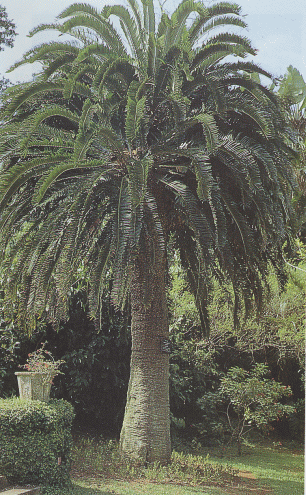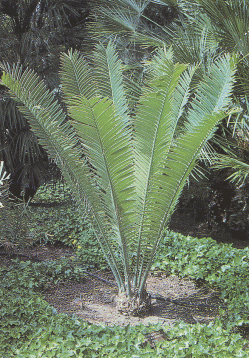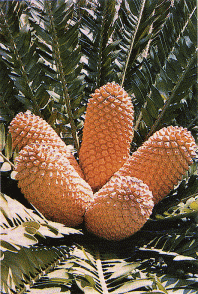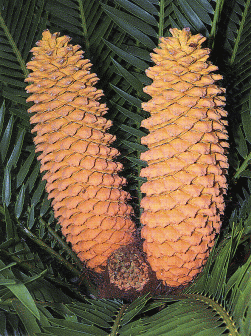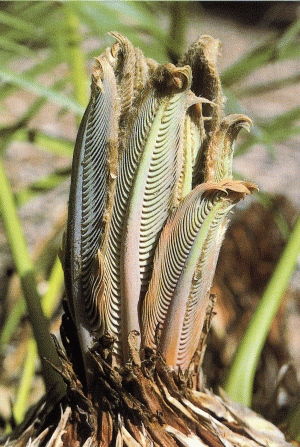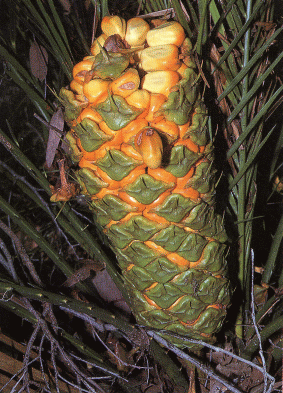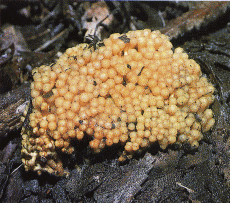I've
mentioned cycads elsewhere on this site, and
I suspected that there would be a lot of people out there who have no
idea what a cycad is. You may have seen them but simply not known them
for what they are, since one or two species are fairly common house
and garden plants, for example, the sago palm. And for all that some of
them look similar to palms, they are not related at all. For years I've
been looking for a good book about cycads, and I recently found one:
Cycads of the World
by David L. Jones, published by the Smithsonian
Institution Press (ISBN 1-56098-220-9). The following text and pictures
I have used from that book without permission.
Cycads are woody plants which produce seeds. Although they may
have a general appearance which is readily identifiable by most people,
they are usually linked to palms or ferns, when in fact they are not
related to either. Cycads are actually a unique assemblage of plants
and although they are grouped with the gymnosperms they are in point of
fact unrelated to any other group of living plants.
Cycads certainly have a distinctive appearance which is
related to their primitiveness or antiquity. Within the living seed
plants they are nearly unique in that they produce motile sperm cells,
and thus are an important link to the earliest of the ancient seed
plants. Cycads flourished in eons past and reached their peak in the
Mesozoic Era some 150 million years ago. While the fossil story may
still be unclear, it is certain that cycads were more varied and
profuse in earlier times and more widely distributed. Today cycads may
be regarded as relicts consisting of small populations distributed
disjunctly on many continents.
Living cycads are found in the tropical, subtropical and warm
temperate regions of both the north and south hemispheres. While
substantial numbers exist on the continents of Africa, Australia
and South America they are also prominent in Central America (which has
the greatest diversity) and the Caribbean Islands. Cycas is the most
widespread genus, with representatives occurring as far north as Japan
and others being scattered throughout various Pacific islands, China and
India to Madagascar and the east coast of Africa.
Cycads are basically woody plants which have roots, a stem,
leaves and reproductive structures known as cones.
The main roots of cycads are thickened and fleshy and as they
may have storage capacities they are often termed tuberous. Along with
the fleshy stem they may have contractile properties which serve to
regulate the level of the stem in the ground. Specialised,
upright-growing, branched roots, known as coralloid roots, are also
produced by all species. These roots contain symbiotic blue-green algae
which can fix nitrogen from the atmosphere.
The stems of cycads may be completely subterranean or emerge
from the ground and be trunk-like. Soil depth may influence this
development and in shallow, stony soils, species which normally have
subterranean stems may develop an above-ground trunk.
The leaves of most cycads are once-divided (pinnate) and often
develop an attractive palm-like crown. Those of Stangeria bear a strong
resemblance to the fronds of a fern, whereas in the Australian genus
Bowenia the leaves are twice-divided (bipinnate).
Cycads reproduce when mature by the production of cones. A
plant is either male or female and the cones of each sex are usually
quite different in size and shape and to a much lesser extent colour.
Specialised woody growths on the cones, called sporophylls, bear the
sexual parts with those of the male cone producing pollen and on a
female cone they bear large ovules which if fertilised develop into
seeds. The seeds of cycads are relatively large and have an outer layer
(sarcotesta) which is often colourful.
